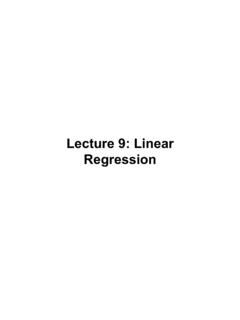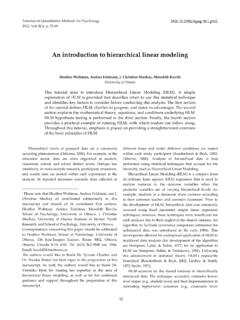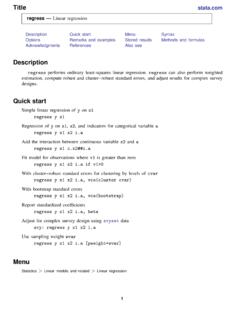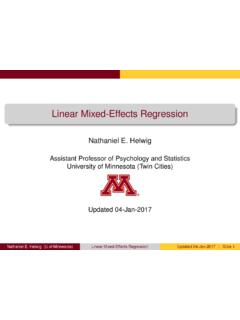Transcription of CHAPTER 1: THE OP AMP - Analog Devices
1 THE OP AMP CHAPTER 1: THE OP AMP INTRODUCTION SECTION : OP AMP OPERATION INTRODUCTION VOLTAGE FEEDBACK (VFB) MODEL BASIC OPERATION INVERTING AND NONINVERTING CONFIGURATIONS OPEN-LOOP GAIN GAIN BANDWIDTH PRODUCT STABILITY CRITERIA PHASE MARGIN CLOSED-LOOP GAIN SIGNAL GAIN NOISE GAIN LOOP GAIN
2 BODE PLOT CURRENT FEEDBACK (CFB) MODEL DIFFERENCES FROM VFB HOW TO CHOOSE BETWEEN VFB AND CFB SUPPLY VOLTAGES SINGLE-SUPPLY CONSIDERATIONS CIRCUIT DESIGN CONSIDERATIONS FOR SINGLE- SUPPLY SYSTEMS RAIL-TO-RAIL PHASE REVERSAL LOW POWER AND MICROPOWER PROCESSES
3 EFFECTS OF OVERDRIVE ON OP AMP INPUTS SECTION : OP AMP SPECIFICATIONS INTRODUCTION DC SPECIFICATIONS OPEN-LOOP GAIN OPEN-LOOP TRANSRESISTANCE OF A CFB OP AMP OFFSET VOLTAGE OFFSET VOLTAGE DRIFT DRIFT WITH
4 TIME SECTION : OP AMP SPECIFICATIONS (cont.) CORRECTION FOR OFFSET VOLTAGE DigiTrim TECHNOLOGY EXTERNAL TRIM INPUT BIAS CURRENT INPUT OFFSET CURRENT COMPENSATING FOR BIAS CURRENT CALCULATING TOTAL OUTPUT OFFSET ERROR DUE TO IB AND VOS BASIC linear DESIGN INPUT IMPEDANCE INPUT
5 CAPACITANCE INPUT COMMON MODE VOLTAGE RANGE DIFFERENTIAL INPUT VOLTAGE SUPPLY VOLTAGES QUIESCENT CURRENT OUTPUT VOLTAGE SWING (OUTPUT VOLTAGE HIGH / OUTPUT VOLTAGE LOW) OUTPUT CURRENT (SHORT-CIRCUIT CURRENT) AC SPECIFICATIONS NOISE VOLTAGE NOISE NOISE BANDWIDTH NOISE FIGURE CURRENT NOISE TOTAL NOISE (SUM OF NOISE SOURCES) 1/f NOISE (FLICKER NOISE)
6 POPCORN NOISE RMS NOISE CONSIDERATIONS TOTAL OUTPUT NOISE CALCULATIONS DISTORTION THD (TOTAL HARMONIC DISTORTION) THD + N (TOTAL HARMONIC DISTORTION PLUS NOISE) INTERMODULATION DISTORTION THIRD+C65 ORDER INTERCEPT POINT (IP3), SECOND ORDER C56 INTERCEPT POINT (IP2) 1 dB COMPRESSION POINT SNR (SIGNAL TO NOISE RATIO) ENOB (EQUIVALENT NUMBER OF BITS) OP AMP SPECIFICATIONS (cont.)
7 SPURIOUS-FREE DYNAMIC RANGE (SFDR) SLEW RATE FULL POWER BANDWIDTH 3 dB SMALL SIGNAL BANDWIDTH BANDWIDTH FOR dB BANDWIDTH FLATNESS+C65 GAIN-BANDWIDTH PRODUCT CFB FREQUENCY DEPENDANCE SETTLING TIME RISE TIME AND FALL TIME PHASE MARGIN CMRR (COMMON-MODE REJECTION RATIO) PSRR (POWER SUPPLY REJECTION RATIO)
8 DIFFERENTIAL GAIN DIFFERENTIAL PHASE PHASE REVERSAL CHANNEL SEPARATION ABSOLUTE MAXIMUM RATING REFERENCES THE OP AMP SECTION : HOW TO READ DATA SHEETS THE FRONT PAGE THE SPECIFICATION TABLES THE ABSOLUTE MAXIMUMS THE ORDERING GUIDE THE GRAPHS THE MAIN BODY SECTION : CHOOSING AN OP AMP STEP 1: DETERMINE THE PARAMETERS STEP 2: SELECTING THE PART BASIC linear DESIGN THE OP AMP INTRODUCTION CHAPTER 1: THE OP AMP Introduction In this CHAPTER we will discuss the basic operation of the op amp, one of the most common linear design building blocks.
9 In section 1 the basic operation of the op amp will be discussed. We will concentrate on the op amp from the black box point of view. There are a good many texts that describe the internal workings of an op amp, so in this work a more macro view will be taken. There are a couple of times, however, that we will talk about the insides of the op amp. It is unavoidable. In section 2 the basic specifications will be discussed. Some techniques to compensate for some of the op amps limitations will also be given.
10 Section 3 will discuss how to read a data sheet. The various sections of the data sheet and how to interpret what is written will be discussed. Section 4 will discuss how to select an op amp for a given application. BASIC linear DESIGN THE OP AMP OP AMP OPERATION SECTION 1: OP AMP OPERATION Introduction The op amp is one of the basic building blocks of linear design. In its classic form it consists of two input terminals, one of which inverts the phase of the signal, the other preserves the phase, and an output terminal.
















